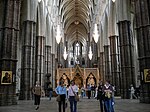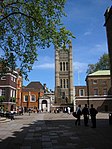City and Liberty of Westminster
History of the City of WestminsterHundreds and divisions of MiddlesexLiberties of London

The City and Liberty of Westminster was a unit of local government in the county of Middlesex, England. It was located immediately to the west of the City of London. Originally under the control of Westminster Abbey, the local authority for the area was the Westminster Court of Burgesses from 1585 to 1900. The area now forms the southern part of the City of Westminster in Greater London.
Excerpt from the Wikipedia article City and Liberty of Westminster (License: CC BY-SA 3.0, Authors, Images).City and Liberty of Westminster
Way of the Monks, London Millbank
Geographical coordinates (GPS) Address Phone number Website Nearby Places Show on map
Geographical coordinates (GPS)
| Latitude | Longitude |
|---|---|
| N 51.499 ° | E -0.128 ° |
Address
Westminster School
Way of the Monks
SW1P 3PF London, Millbank
England, United Kingdom
Open on Google Maps









